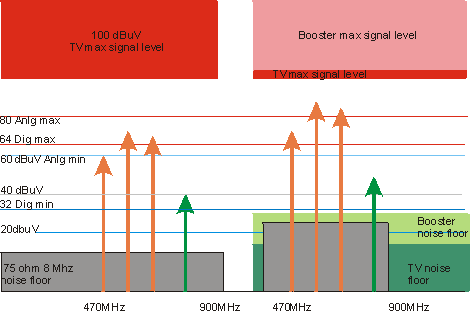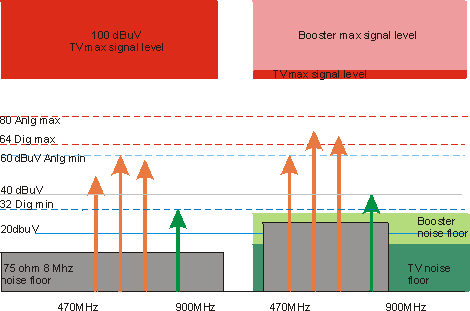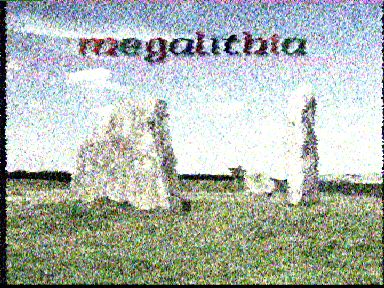

Mo' Betta has got one simple principle in life. If some is good, 'more better'. One amp makes a set-top aerial perform like a good loft aerial, so two or three make it perform like a Televes 75 on the roof! It's not really fair to rant about the popular misuse of booster amplifiers without backing the rant up with facts. So here's the lowdown. All you really need to know is
Never use a booster in the same room as the TV unless to split the feed.
Never, ever, directly cascade UHF amplifiers/boosters
Why not? One is good, surely two are better? Works with ten pound notes, why not boosters? These examples use analogue, where the effect is immediately clear. The principles are the same for digital, but the manifestation of the problem in picture freezes is hellishly difficult to put across in a web still!

I ask you - are the two halves of this picture of equal quality?
Would you be surprised to hear the left half was video captured coming in to the receiver 58dBuV, right half coming in a 59dBuV? Right-hand should be a tad better. So what went wrong?
The right hand image is what you get if your aerial is 44dB worse than the left which is at about minimum specified level (60dBuV), and you use two 22dB TV booster amplifiers in series to make up for that! That's right - if you are so desperately short of signal that you need two boosters in series to get up to the minimum signal level, you aren't going to enjoy watching it. These are real signals captured from real TV equipment.
What has once been lost can never be regained
Okay, so you wouldn't do that. But just one signal booster is okay, huh? I hit the signal with a 20dB loss and put in the 22dB amp for the right-hand side.

left half is original, right is 20dB attenuated and amplified by 22dB
It's less obvious, so I've shown you full size. The problem with trying to show TV quality on the web with vidcaps is the pictures don't move - it's the shimmering effect of the noise as it changes from frame to frame which is the major bugbear with it. Never the less, the right-hand side is definitely worse than the left.
So what was it like before we put the booster in. Must've been awful, eh, something like the right hand half of the top picture? Glad you asked - here it is. The half without the booster is on the left, with is on the right

Okay, it's a teeny bit better with the booster. The VCR performing the receive function is about 1992 vintage. Modern receivers cope with low signal levels better as their noise figures tend to be lower. Even given that old receiver, we aren't talking a night-and-day difference. Both results suck. Is it worth £20 to you? Would you get a better result spending £15 on a cheapo aerial and the cable to stick it in the loft? Probably....
What has once been lost can never be regained
You can see how the quality varies in the results of an experiment, in which the signal was kept at a more controlled level into the receiver and the minimum system level was varied.
Here's the engineering behind it. Let's start out with the specs [1], shall we.
| Signal level limit specifications (at aerial socket plate in your living room) | |||
|---|---|---|---|
| Service | Minimum level (dBuV) | Maximum level (dBuV) | C/N ratio |
| UHF Analogue TV | 60 | 80 | 43 |
| UHF DTT | 32 (45 recommended) | 55 | 26 |
| DAB radio | 30 | 65 | 18 |
| FM radio | 54 | 74 | 45 |
Let us put in a reasonable set of signals for a medium distance area
| Channel | Type | level (dBuV,75R) |
| 26 | Analogue | 60 |
| 33 | Analogue | 74 |
| 45 | Analogue | 70 |
| 56 | DTT[1] | 40 |
| all | noise floor (in 8MHz BW) | 10 |
DTT is on the low side but not outrageously so, analogue reception has a reasonable spread and is just within spec. Let's put in our trusty Maxview SSB1CRG
| Bandwidth (MHz) | 40-860 |
| Noise Figure | 3dB |
| Gain | 14dB |
| Max O/P (2ch) -46dB Cross Mod |
110dBuV |
| Max O/P (5ch) -46dB Cross Mod |
104dBuV |

Fig.1 within spec aerial signal into booster
A perfectly respectable performance. Purists would argue two of the analogue channels have gone over the top from a spec point of view, but you'd be likely to get away with this in most cases. Trouble is, you haven't gained anything, and what you have also done is lost 14dB of impulse noise immunity and wasted 20 pounds, and taken up a mains socket you could be using for something else.
Impulse noise - the sort of thing generated by sparks at light switches, thermostats etc is a large problem on DTT, giving you intermittent picture freezes. These signals occasionally have more energy in the frequency range of your TV channel than the signal you are watching, in which case you will by definition get a disturbance. Far more often the freezes are caused by large signals outside the frequency range of your channel going beyond the capacity of your set-top input stages to handle, thus spreading out across the band into all channels within your receiver. A booster of 14dB gain brings that 14dB closer to happening for you, which is not a good thing.
Let's face it, this is not what the 'more better' school of thought uses boosters for - because the reason they want a booster is because the aerial is not up to scratch. Let's take the same signal, but allow for a lack of aerial height (-10db) and poorly designed aerial (-4dB). You'd probably lose even more but I wanted the loss to be exactly what can be made up with the booster. Red values are out of spec.
| Channel | Type | level (dBuV,75R) |
| 26 | Analogue | 46 |
| 33 | Analogue | 60 |
| 45 | Analogue | 56 |
| 56 | DTT[1] | 26 |
| all | noise floor (in 8MHz BW) | 10 |
Before he put in the booster 'more better' had admit that his analogue reception was iffy on two channels and his DTT stank. But that's alright - bring on the booster, and everything is back up to spec as above
Let's look at that spectrum

Fig 2 Poor aerial followed by booster.
looks fab, really, all signals in spec. What the hell am I talking about - a set-top aerial followed by a booster is delivering fully in spec signals. Should be no difference, but there is a difference in the picture
The devil is in the difference between wanted signal and the noise. If you compare the amount of the arrows clear of the noise floor between fig.1 and fig.2 it is sill a lot less in fig 2. The booster hasn't improved that. That is why there are minimum specs for signal levels - because once the signal level has fallen below a certain level, the thermal noise of the system which is always present will be too large a proportion of the signal to maintain quality. You will end up watching this

instead of this

and you wouldn't want to do that...
Selecting and siting your TV aerial
Signal quality variation with falling input level
real aerial measurement of DTT performance with decreasing signal levels + adding booster
Why DTT is different from an analogue install